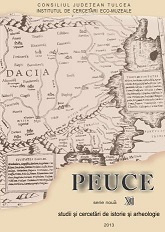New possible approach on the significance of “arrowhead”- shaped monetary signs especially cast for trade purposes
New possible approach on the significance of “arrowhead”- shaped monetary signs especially cast for trade purposes
Author(s): Gabriel Mircea TalmaţchiSubject(s): Archaeology
Published by: Institutul de Cercetari Eco-Muzeale Tulcea - Institutul de Istorie si Arheologie
Keywords: Dobrudja; Black Sea; monetary signs; trade; pre-Roman period
Summary/Abstract: The subject we selected for this paper answers some personal concerns to which we have already dedicated a few years of research. One of the main questions we put is: what connections are between the shape of these monetary signs and everyday realities in the 6th-5th century B.C.? Also, if they were commercial items, what was their significance, as they don’t fully express the currency functions? Were they made in "arrowhead" shape without ultimately symbolizing anything of the purpose for which they were created? Is there a more elaborate answer in this regard or should we find a very simple explanation, as we consider we should identify for that period? In fact, arrowheads-monetary signs represent measurable symbols of some economic and trade realities, used under certain regionally established “standards”. They were designated as counterparties for goods, like grain and fish. These seem to be the most sought after commodities of the Greek population and the monetary signs could also be the representation of grains (as in the classic pieces case), or of marine fish, respectively. Our opinion is that the interpretation was unequivocal (more precisely their significance and purpose) for the 6th-5th centuries B.C. population, understood by all (and we are not referring to the classic battle arrowheads, to a probable military connection). We consider, as a hypothesis, that we have to establish a link with the economic elements of everyday life, with the economic and commercial necessity in the early relations established between the Greeks and the natives (namely the Getae). In our opinion, when casting these monetary signs, certain local trade elements were taken into consideration; thus they seem to not symbolically render a battle weapon (the military arrowhead), but the very commodity for whose trading they were created: grains of wheat or barley, or fish products, etc. We were inspired in these new considerations by the study of monetary iconography specific to the Greek world. Besides the characteristic elements of the local or general Pantheon (gods and their attributes), the Greek centres and the poleis also imprinted the main sources of income – such as fish, cereals (ears or grains), pottery, etc. – on the observe and reverse of their monetary types. There are numerous examples to this effect, valid in the entire Greek world, especially in the colonies. The specimen we will refer to were cast from the first half of the 5th century B.C. However, they couldn’t have been chronologically simultaneous, as they were distinguished by the financial and monetary processes and phenomena, by the stages of execution of the measurable products, by the transition from a half-standardized symbol to a generally accepted symbol in the known “civilized” world, characteristic to the respective periods. The most significant examples that support our endeavour to establish probable connections between the analyzed monetary signs (ah-hoc considered “arrow
Journal: Peuce (Serie Nouă) - Studii şi cercetari de istorie şi arheologie
- Issue Year: XI/2013
- Issue No: 11
- Page Range: 307-326
- Page Count: 20
- Language: English

